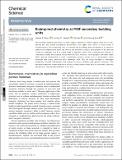| dc.contributor.author | Bour, James R. | |
| dc.contributor.author | Wright, Ashley Michael | |
| dc.contributor.author | He, Xin | |
| dc.contributor.author | Dinca, Mircea | |
| dc.date.accessioned | 2021-02-08T21:47:23Z | |
| dc.date.available | 2021-02-08T21:47:23Z | |
| dc.date.issued | 2020-01 | |
| dc.date.submitted | 2019-12 | |
| dc.identifier.issn | 2041-6520 | |
| dc.identifier.issn | 2041-6539 | |
| dc.identifier.uri | https://hdl.handle.net/1721.1/129714 | |
| dc.description.abstract | The secondary building units (SBUs) in metal-organic frameworks (MOFs) support metal ions in well-defined and site-isolated coordination environments with ligand fields similar to those found in metalloenzymes. This burgeoning class of materials has accordingly been recognized as an attractive platform for metalloenzyme active site mimicry and biomimetic catalysis. Early progress in this area was slowed by challenges such as a limited range of hydrolytic stability and a relatively poor diversity of redox-active metals that could be incorporated into SBUs. However, recent progress with water-stable MOFs and the development of more sophisticated synthetic routes such as postsynthetic cation exchange have largely addressed these challenges. MOF SBUs are being leveraged to interrogate traditionally unstable intermediates and catalytic processes involving small gaseous molecules. This perspective describes recent advances in the use of metal centers within SBUs for biomimetic chemistry and discusses key future developments in this area. | en_US |
| dc.description.sponsorship | National Science Foundation (Grant DMR-1452612) | en_US |
| dc.language.iso | en | |
| dc.publisher | Royal Society of Chemistry (RSC) | en_US |
| dc.relation.isversionof | http://dx.doi.org/10.1039/c9sc06418d | en_US |
| dc.rights | Creative Commons Attribution Noncommercial 3.0 unported license | en_US |
| dc.rights.uri | https://creativecommons.org/licenses/by-nc/3.0/ | en_US |
| dc.source | Royal Society of Chemistry (RSC) | en_US |
| dc.title | Bioinspired chemistry at MOF secondary building units | en_US |
| dc.type | Article | en_US |
| dc.identifier.citation | Bour, James R. et al. "Bioinspired chemistry at MOF secondary building units." Chemical Science 11, 7 (January 2020): 1728-1737 © The Royal Society of Chemistry | en_US |
| dc.contributor.department | Massachusetts Institute of Technology. Department of Chemistry | en_US |
| dc.relation.journal | Chemical Science | en_US |
| dc.eprint.version | Final published version | en_US |
| dc.type.uri | http://purl.org/eprint/type/JournalArticle | en_US |
| eprint.status | http://purl.org/eprint/status/PeerReviewed | en_US |
| dc.date.updated | 2020-09-21T13:49:09Z | |
| dspace.date.submission | 2020-09-21T13:49:12Z | |
| mit.journal.volume | 11 | en_US |
| mit.journal.issue | 7 | en_US |
| mit.license | PUBLISHER_CC | |
| mit.metadata.status | Complete | |
